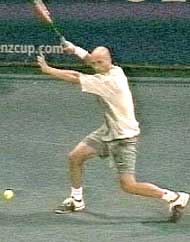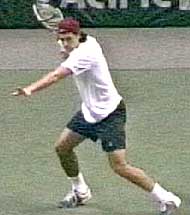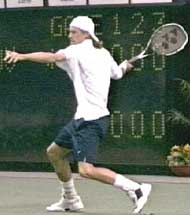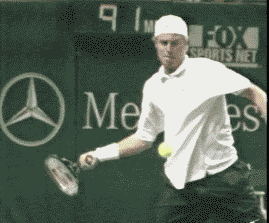<% ns_puts [mkm_getnavbar] %>
Building the Modern Forehand
by John Yandell
Page 2
|
|
Start of The Backswing
As the players move from the unit turn to the full turn, they also initiate the backswing. At this point, some players, like Sampras, separate their hands. Others, like Agassi and Hewitt, keep their opposite hand on the throat of the racquet until the hands reach shoulder level.
This variation probably doesn’t matter too much. The key point, is that after the hands separate, the left arm extends across the body. Meanwhile the racquet hand is moving upward in some form of looping motion. The exact position of the racquet hand at the completion of the turn can vary greatly depending on the player and the type of ball he is hitting.
Some players—Agassi and Hewitt, for example—reach the top of the backswing just as they complete the turn, so that the racquet hand is higher. Other players such as Sampras or Kuerten have a slightly lower hand position and have already dropped the racquet somewhat below the highest point of the motion. This position can also vary when players are on the move, when most players compact the swing at least somewhat, but more on this in later articles.
To summarize, when a player reaches the Full Turn, he has this characteristic look:
- The shoulders turned slightly past perpendicular
- The head turned to track the ball with the chin over the front shoulder>
- The left arm pointing across the body at the sideline
- The racquet hand at shoulder level or higher
It doesn’t matter if you’re at Pete Sampras, Andre Agassi, Lleyton Hewitt, Gustavo Kuerten, Marat Safin or Tommy Haas. Their forehands all share these elements, with only minor variations.
The Completion of the Turn Across Grip Styles   The common elements in the Full Turn: shoulders slightly past perpendicular to the net, left arm extended to the sideline, racquet hand high.    |
Timing
Another critical element in the Full Turn is the timing. It should feel like it happens in a flash. The start of the turn, we noted, takes only about 2/10s of a second. The additional movement to the Full Turn takes about another 3/10s of a second. That’s a total of about ½ second from the start to the completion of the preparation! The turn move could be technically perfect but still far too slow. It needs to feel decisive and instantaneous.
|
|
On many balls, pro players reach the Full Turn by the time the ball bounces on their side of the court. In club tennis, the goal should be to reach the turn at this point or sooner.
A sense of urgency is key, but this is something far too many players lack. Commonly, they wait for the ball to bounce before starting to prepare. As a result they are chronically rushed, late, and/or forced to muscle the ball at contact, like our friend from the San Francisco Tennis Club who focused on the shape of Agassi’s backswing.
Set Up and Alignment
After the turn, the next commonality in all modern forehands is the set up or alignment to the ball, including the coiling of the back leg. Again, there is a characteristic position top players reach when they have time to set up for the ball.
Without exception, they set up on the outside foot, or the foot closest to the ball. This is the right foot for a righthander. This outside foot is turned sideways. It can be parallel to the baseline. It can also be turned somewhat forward, with the toes pointing at the net an an angle of thirty to forty five degrees. Most of the weight is on this outside foot, with that foot typically completely flat on the court. The torso is erect, more or less completely straight up and down from the waist.
|
|
There is a substantial knee bend in the outside leg, up to as much as 45 degrees. This leg coil is critical in the modern game both for generating power, and also for controlling the contact height as we’ll see in a future article.
The other foot (the left foot for a righthander) is also turned at least partially sideways and is in front of the outside foot, and closer to the net. The player is usually up on the toes of this foot to keep balance.
The player establishes this position fairly close to the line of the incoming ball. Often this is called setting up “behind the ball.” He is now in position to hit without having to make any further positioning adjustments.
The distance between the feet is related to the hitting stance the player will use. The distance is usually shoulder width or wider for open stance shots. The left foot can also be up much closer to the right when the player plans to step in. (We’ll take a detailed look at the all variations in the stances as well as what happens to the feet during and after the hit in the upcoming articles.)
   Agassi shows the variations in the position of the feet at the setup. At left, a semi-open forehand. In the center, fully open. At the right, preparing to step in. |
On balls that require little or no movement, the set up can coincide with the completion of the turn. The player will actually come to a full stop with the leg fully coiled at about the time he reaches the full turn. It can be taught this way, as a basic sequence in developing the fundamentals: Start of Turn, Completion of Turn, and then immediately, Set Up and Coil. However it is also important to note that the turn and the set up are actually independent elements that usually don’t occur at the same time when the player has to move to the ball.
|
|
The further the movement, the later the set up occurs in relation to the rest of the swing. For example, when the player takes two steps to the ball, the backswing can drop to shoulder level, with the left arm moving back across the body as the torso rotation begins.
If there is more movement, the racquet can be near the bottom of the backswing and almost ready to start forward to the ball at the time, with the left arm pointing toward the net.
This is why it is critical to teach the start of the turn and the completion of the turn as the first two movements. If players are taught to always pair them with the set up, their timing will be late on the vast majority of balls.
Obviously, when players hit on the move they never come fully to rest in the set up. However, in almost all cases, they will still pass through the set up position, with the weight on the outside leg and the outside knee bent as deeply as possible. If you look closely, you’ll see that even when player’s appear to be on the run, there is a different pattern to the final step before the hit.
Variations in Timing the Setup Across Grip Styles   Note the variation in the timing of the set up. The differences are in the position of the left arm, the height of the racquet hand, and the rotation of the torso.    |
You can see this in the way the foot moves on and off the court. As players start to move toward the ball, they tend to stay mainly on the balls and/or the toes of their feet. When they take the set up step, however, this changes. On the last step before the hit, they land heel first. This is a “braking step” that slows them down somewhat. As they brake, they coil the back leg by deepening the knee bend.
|
|
This is usually at the time of the set up, true even when they continue to move through the shot at what appears to be full speed. This braking step—and the extra knee bend that goes with it—is a subtle but very important element is learning to hit effectively on the move.
Completion of Backswing-Start of the Foreswing
The next commonality is the position of the arm and racquet at the completion of the backswing. Regardless of the size and shape of the backswing, all top players reach this position just as the racquet starts forward to the ball. In fact, it’s not going so far to say that the main purpose of the backswing is to deliver the hitting arm to this position.
The position of the hitting arm and racquet at the completion of the backswing is one of the most misunderstood technical points in the modern game.
As the racquet drops to the bottom of the backswing, the arm settles into a characteristic “hitting position,” what I’ve also called the power palm position. This hitting arm position has two distinctive elements that are common across the grip styles. The elbow is bent and tucked in toward the torso, and the wrist is laid back.
The exact angle of the arm and the amount of wrist lay back can vary somewhat from player to player, and also, with the height of the ball. But the basic elements are virtually universal among modern players: elbow in, wrist laid back. (For an exception check out Mark Philippoussis in the Advanced Tennis footage.)
|
|
This position is critical because it allows the palm of the hand to drive the racquet to the contact point—and beyond. It is also critical because it positions the racquet head correctly for the upward swing to the ball to generate topspin.
One of the most inaccurate and damaging tennis tips of all time is the idea that players should drop the racquet head far below the level of the ball to create topspin. What the high speed video shows is that in reality the racquet head is usually only a few inches below the ball at the start of the foreswing. This is for pro players who are generating phenomenal amounts of topspin, sometimes exceeding 3000rpm!
The key is not trying to drop the racquet way below the ball. The key is finding the hitting arm position at the completion of the backswing. Dropping the racquet further, will actually impede your ability to generate spin, as well as reduce or destroy the consistency and power of your forehand.
Finding the hitting arm position at the end of the backswing will position the racquet perfectly to hit through the ball with power, to generate the right amount of spin for the given situation, and to hit the forehand with consistent technical precision over time.
The Hitting Arm Position Across the Grip Styles   All top players find the hitting position at the start of the foreswing, with the racquet only slightly below the ball.    |
You can spend years developing the most beautiful circular loop in the history of tennis, and the effort will be completely wasted and counterproductive if you don’t end up in this position. That’s why in my basic teaching system, (see the Visual Tennis series) I still advocate the straight backswing. It’s the easiest way there is to set up the hitting arm.
|
|
Contact
As we have examined in detail (Myth of Wrist Forehand), the common belief that the “wrist snap” is the key to power on the modern forehand is a myth. In fact the critical hitting arm position the player established at the completion of the backswing remains essentially unchanged as the player swings forward and upward to contact.
Ironically, this laid back position is usually more extreme with the western forehand grips—typically the forehands considered to have the most “wrist action” at contact.
The exact angle of the wrist lay back may decrease slightly as the palm drives the racquet forward, but on virtually every forehand hit by every top player, the wrist remains laid back at contact at an angle of about 45 to 60 degrees.
The Wrist Position at Contact Across Grip Styles   The wrist remains laid back at contact across the grip styles.    |
Amazingly, this is even true on low balls close to the net. Check out the incredible video of Lleyton Hewitt for yourself. He may appear to roll the wrist radically. Look closer at the frame by frame and see how he lifts the ball with the wrist laid back. The huge racquet rollover happens well after the contact and is just one more example of how our naked eyes deceive us when we look at pro tennis.
To contact us, please email to: webmaster@tennisone.com
TennisONE is a registered trademark of TennisONE and SportsWeb ONE; Copyright 1995. All rights reserved.








